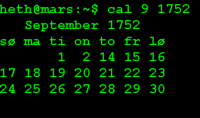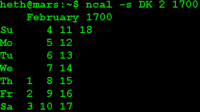Calendar standards
The purpose of this article is to describe the necessary background information to understand calendar issues on the Internet and in computer calendar systems.
Western calendar standards
In the western world we are using the Gregorian calender which is a solar calendar following the seasons and the Earths orbit around the Sun. Some calendars follow the rotation of the Moon around the earth, for example the Islamic calendar (lunar Hijri)[1].
The Gregorian calendar divides the year into 12 months and the months into the following number of days.
| No. | Name | Days |
|---|---|---|
| 1 | January | 31 |
| 2 | February | 28 or 29 |
| 3 | March | 31 |
| 4 | April | 30 |
| 5 | May | 31 |
| 6 | June | 30 |
| 7 | July | 31 |
| 8 | August | 31 |
| 9 | September | 30 |
| 10 | October | 31 |
| 11 | November | 30 |
| 12 | December | 31 |
Julian calendar
The Julian calendar[2] was introduced by Julius Caesar in 46 BC and was the dominant calendar in the western world, until it was superseded by the Gregorian calendar.
- NOTE:
- The term Julian day[3] is the number of the day counted from January 1st 4713 BC but also sometimes referred to as the day number in the year, counted from January. 1st and should not be confused with the Julian calendar
Leap year
The Earths rotation of the Sun is not exactly 365 days, but sligtly higher. To avoid drift over centuries between the calendar year[4] and the astronomical year[5] or the seasons, it was necessary to add an extra day at intervals.
The Julian calendar has 12 months, 365 days and a leap day added in February every four years giving an average year of 365,25 days or 365 days and 6 hours.
<math>\text{Average year} = 365 \text{ days/year } + {1 \over 4} = 365,25 \text{ days}</math>
Problem with the Julian calendar
The actual average earth year is a few minutes shorter than 365,25 days meaning that the calendar gained about three days every four centuries.
The historical Julian calendar is currently 13 days advanced of the Gregorian calendar.
Gregorian calendar
In the western world we are following the Gregorian calendar[6] also called the Western or the Christian calendar. The Gregorian calendar is internationally the most widely accepted calendar and are used as civil calendar as standardized in ISO-8601[7] -- Representation of dates and times .
It was discovered that the actual average earth year was nearly 365,2425[8] days instead of the Julian 365,25 days, which lead to the calendar reform in the year 1582 introduced by Pope Gregory XIII[9].
Gregorian leap year
To compensate for the drift in the Julian calendar the rules for the leap year was changed to:
- Rule 1: The year is evenly divisible by 4;
- Rule 2: If the year can be evenly divided by 100 it is NOT a leap year.
- Rule 3: Exception from rule 2 - If the year is evenly divisible by 400 it is a leap year.
Number of leap years in a 400 year period
Given the rule above there will be 97 leap years in a period of 400 years
<math>rule_1 - rule_2 + rule_3 = ( {400 \text{ year} \over 4 \text{ year}} ) - ( {400 \text{ year} \over 100 \text{ yeas}} ) + ( {400 \text{ year} \over 400 \text{ year}} ) = 97</math>
Number of days in a 400 years period
<math>\text{days in 400 year } \eqcirc 400 \text{ year} * 365 \text{ days/year} + 97 \text{ days } \eqcirc 146097 \text{ days}</math>
Average year length in a 400 years period
Given from above that there are 97 leap years in a 400 years period, the average year length will be
<math>\text{Average year} = {\text{ days in 400 year } \over 400 \text{ year}} = {146097 \text{ days} \over 400 \text{ year}} = 365,2425 \text{ days/year}</math>
Adoption of the Gregorian calendar
The Gregorian calender was adopted by various countries on different dates. When switching from the Julian to the Gregorian calendar it was necessary to adjust the calender by dropping the the days accumulated in the nearly 1800 years since the Julian calender was introduced.
By example the Gregorian calender was adopted by Denmark March 1st 1700[10] by dropping the last 11 days of February. The British Empire adopted the Gregorian calender September 14th 1752.
In the western world today we refer to the British adoption of the Gregorian calender September 14th 1752.
Problems with the Gregorian calendar
The Gregorian calendar is a Solar calendar whose dates indicate the position of the earth on its revolution around the sun. The observed average day of 365.2425 achieved with the above explained leap year, is still a approximation missing about 1 day every 3.000 years.
Weeks
A week[11] is a time unit equal to seven days. It is the standard time period used for cycles of work days and rest days in most parts of the world. The ISO 8601 week begins with Monday and ends with Sunday.
Not all parts of the world have a work week that begins with Monday. For example, in some Muslim countries, the work week may begin on Saturday, while in Israel it may begin on Sunday. In the US the work week is often defined to start on Monday, although the week itself is usually considered to start on Sunday[12]
Week numbers
Week numbers are used in some European and Asian countries, but rare elsewhere[13]. Week numbers are standardized by ISO-8601 which states week 1 is "The week with the year's first Thursday in it." Another definition for week 1 is "The week with January 4th in it."
A ISO-8601 year consists of either 52 or 53 weeks, depending on if it's leap year or the date of the first Thursday in the year.
EU and most European countries use the ISO-8601 week numbering standard.
Other week numbering standards
- In Canada, USA[14] and Mexico the first week is "The week with the year's first Saturday[15] in it."
- In most of the Middle East the first week is "The week with the year's first Friday in it."
Holidays
Some holidays are dependent on astronomical events and may have different dates in the Julian or Gregorian calender on each occurrence. Some examples shown below.
The Christian Easter
The Western Christianity Easter[16] use the Gregorian calender. Easter always falls on a Sunday between 22nd March and 25th April inclusive, within about seven days after the astronomical full moon. The following day, Easter Monday, is a legal holiday in many countries with Christian traditions.
In Eastern Christianity the Easter is based on the Julian Calender[17].
The Muslim Ramadan
The Muslim Ramadan[18] is the ninth month of the Islamic calender[19]. The Islamic calender is a lunar calendar following the moon phases.
References
- ↑ Islamic calendar (lunar Hijri)
- ↑ Julian calendar
- ↑ Julian day
- ↑ Calendar year
- ↑ Astronomical year
- ↑ Gregorian calendar
- ↑ ISO 8601 -- Representation of dates and times
- ↑ Gregorian calender accuracy
- ↑ Pope Gregory XIII introduced the Gregoiran calendar
- ↑ Year of adopting the Gregorian calender
- ↑ The seven day week
- ↑ Week start day
- ↑ ISO 8601 week dates
- ↑ Calculate the Day Number and Week Number in ISO-8601 and US standard
- ↑ Week numbering standards
- ↑ Easter date
- ↑ Easter date
- ↑ Ramadan
- ↑ Islamic calender

